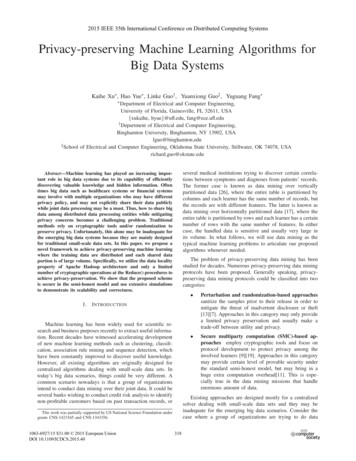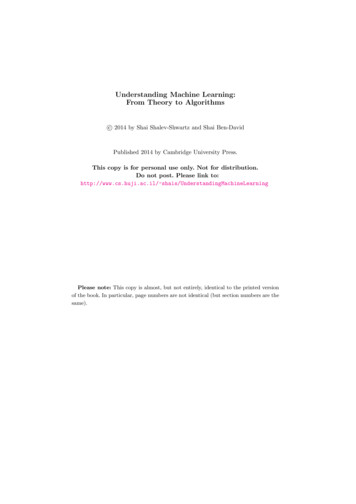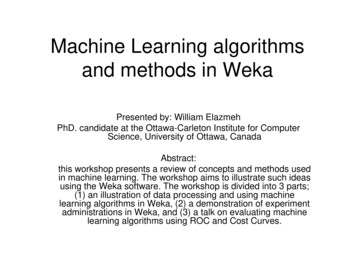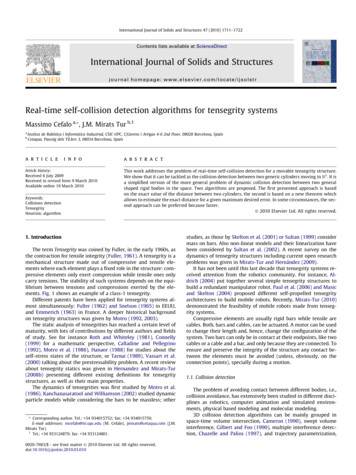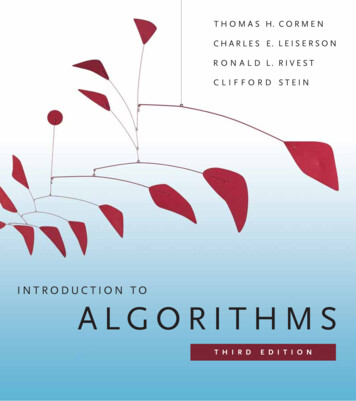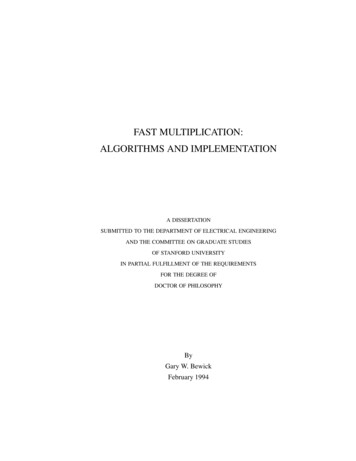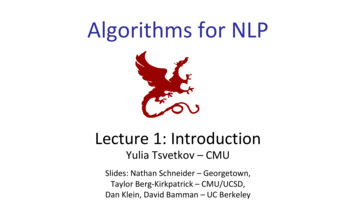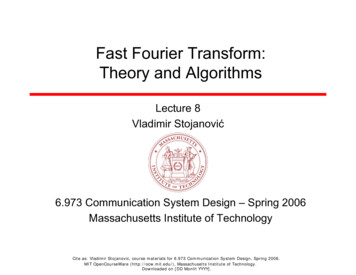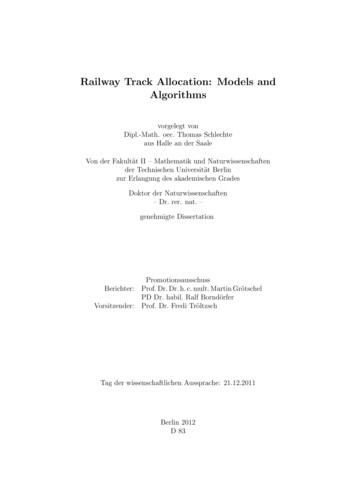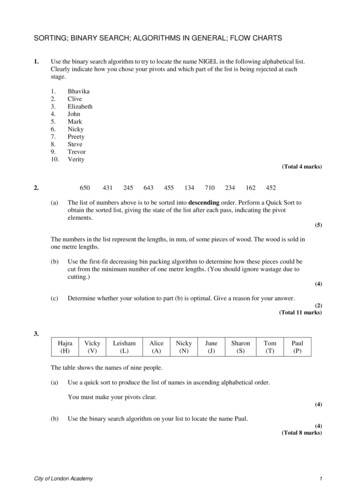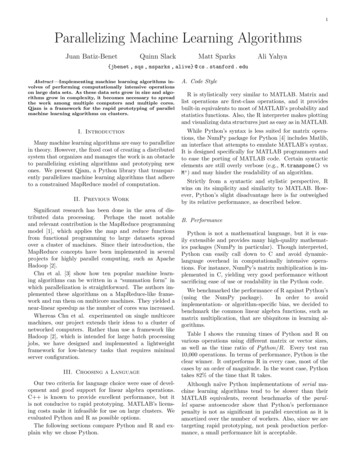
Transcription
1Parallelizing Machine Learning AlgorithmsJuan Batiz-BenetQuinn SlackMatt SparksAli Yahya{jbenet , sqs , msparks , alive} @ cs . stanford . eduAbstract—Implementing machine learning algorithms involves of performing computationally intensive operationson large data sets. As these data sets grow in size and algorithms grow in complexity, it becomes necessary to spreadthe work among multiple computers and multiple cores.Qjam is a framework for the rapid prototyping of parallelmachine learning algorithms on clusters.I. IntroductionMany machine learning algorithms are easy to parallelizein theory. However, the fixed cost of creating a distributedsystem that organizes and manages the work is an obstacleto parallelizing existing algorithms and prototyping newones. We present Qjam, a Python library that transparently parallelizes machine learning algorithms that adhereto a constrained MapReduce model of computation.II. Previous WorkSignificant research has been done in the area of distributed data processing. Perhaps the most notableand relevant contribution is the MapReduce programmingmodel [1], which applies the map and reduce functionsfrom functional programming to large datasets spreadover a cluster of machines. Since their introduction, theMapReduce concepts have been implemented in severalprojects for highly parallel computing, such as ApacheHadoop [2].Chu et al. [3] show how ten popular machine learning algorithms can be written in a “summation form” inwhich parallelization is straightforward. The authors implemented these algorithms on a MapReduce-like framework and ran them on multicore machines. They yielded anear-linear speedup as the number of cores was increased.Whereas Chu et al. experimented on single multicoremachines, our project extends their ideas to a cluster ofnetworked computers. Rather than use a framework likeHadoop [2], which is intended for large batch processingjobs, we have designed and implemented a lightweightframework for low-latency tasks that requires minimalserver configuration.A. Code StyleR is stylistically very similar to MATLAB. Matrix andlist operations are first-class operations, and it providesbuilt-in equivalents to most of MATLAB’s probability andstatistics functions. Also, the R interpreter makes plottingand visualizing data structures just as easy as in MATLAB.While Python’s syntax is less suited for matrix operations, the NumPy package for Python [4] includes Matlib,an interface that attempts to emulate MATLAB’s syntax.It is designed specifically for MATLAB programmers andto ease the porting of MATLAB code. Certain syntacticelements are still overly verbose (e.g., M.transpose() vsM’) and may hinder the readability of an algorithm.Strictly from a syntactic and stylistic perspective, Rwins on its simplicity and similarity to MATLAB. However, Python’s slight disadvantage here is far outweighedby its relative performance, as described below.B. PerformancePython is not a mathematical language, but it is easily extensible and provides many high-quality mathematics packages (NumPy in particular). Though interpreted,Python can easily call down to C and avoid dynamiclanguage overhead in computationally intensive operations. For instance, NumPy’s matrix multiplication is implemented in C, yielding very good performance withoutsacrificing ease of use or readability in the Python code.We benchmarked the performance of R against Python’s(using the NumPy package).In order to avoidimplementation- or algorithm-specific bias, we decided tobenchmark the common linear algebra functions, such asmatrix multiplication, that are ubiquitous in learning algorithms.III. Choosing a LanguageTable I shows the running times of Python and R onvarious operations using different matrix or vector sizes,as well as the time ratio of P ython/R. Every test ran10,000 operations. In terms of performance, Python is theclear winner. It outperforms R in every case, most of thecases by an order of magnitude. In the worst case, Pythontakes 82% of the time that R takes.Our two criteria for language choice were ease of development and good support for linear algebra operations.C is known to provide excellent performance, but itis not conducive to rapid prototyping. MATLAB’s licensing costs make it infeasible for use on large clusters. Weevaluated Python and R as possible options.The following sections compare Python and R and explain why we chose Python.Although naı̈ve Python implementations of serial machine learning algorithms tend to be slower than theirMATLAB equivalents, recent benchmarks of the parallel sparse autoencoder show that Python’s performancepenalty is not as significant in parallel execution as it isamortized over the number of workers. Also, since we aretargeting rapid prototyping, not peak production performance, a small performance hit is acceptable.
2Size5075100150250Matrix MultiplicationPythonRPython / .79834.23505.23110.809618.9190 22.97590.8234Element-Wise Matrix MultiplicationSize PythonRPython / R1500.0350 0.15760.22212250.0760 0.37410.20323000.1510 0.68590.22014500.9310 2.09380.44467503.3010 5.41170.6100machines. One RemoteWorker has a single targetmachine that can be reached via ssh. There can bemany RemoteWorkers with the same target (say, inthe case where there are many cores on a machine),but only one target per RemoteWorker. At creation,the RemoteWorker bootstraps the remote machine bycopying the requisite files to run the Worker program,via ssh. After the bootstrapping process completes,the RemoteWorker starts a Worker process on the remote machine and attaches to it. The RemoteWorkeris the proxy between the Master and the Worker.Master — The Master is a Python class that dividesup work and assigns the work units among its poolof RemoteWorker instances. These RemoteWorkerinstances relay the work to the Worker programsrunning on the remote machines and wait for theresults.Size5075100150250Matrix TransposePythonRPython / R0.0010 0.03250.03080.0010 0.06100.01640.0010 0.10300.00970.0010 0.21960.00460.0010 0.61190.0016Figure 1 shows the communication channels betweencomponents on multiple machines.Size250037505000750012500Vector Inner ProductPythonRPython / R0.0040 0.05230.07650.0060 0.07720.07770.0070 0.10300.06800.0100 0.15190.06580.0160 0.25140.0636Masterqjam LibraryLibraryMasterTABLE IBenchmarks of Python and R for linear algebra operations.Worker 1RemoteWorkerRemoteWorkerSlaveSlaveSlaveWorker 3IV. ArchitectureWorker 2RemoteWorkerWorker 4This section describes the architecture of the qjamframework. Subsection A defines the major componentsof the system and how they communicate with each other.Subsection B explains the programming interface. Subsection C describes the protocol that Qjam uses to communicate. Finally, subsection D describes details of Qjam’sPython implementation.RemoteWorkerRemoteWorker poolcorn10corn11localhostFig. 1. Master controlling four RemoteWorkers with Workers in twomachines.A. ComponentsB. Qjam Library APIQjam is a single-master distributed system made up ofinstances of the following components:This section describes the interface exposed by Qjamand provides a simple example of its use. The workflow ofa typical distributed computation on Qjam is divided intotwo phases. In the initialization phase, the client createsan instance of the Master class by passing its constructora list of remote workers. In the execution phase, the clientspecifies a Python module containing a function, mapfunc,to be executed on each worker along with a dataset anda list of parameters for the computation. The frameworkthen breaks the dataset into smaller pieces and distributesthe work to the worker processes. The following two sub-Worker — The Worker is a program that is copied toall of the remote machines during the bootstrappingprocess. It is responsible for waiting for instructionsfrom the Master, and upon receiving work, processingthat work and returning the result.RemoteWorker — The RemoteWorker is a specialPython class that communicates with the remote
SHORT NAMES: PARALLELIZING MACHINE LEARNING ALGORITHMSsections elaborate on the details.B.1 InitializationAt a fundamental level, the Qjam library is built on topof the RemoteWorker class. An instance of RemoteWorkerdefines a single connection to a worker node. A collection of RemoteWorker objects is passed to the constructorof Master to define the pool of workers available to themaster.The following code demonstrates the initialization of theworker pool and master.workers n17.stanford.edu’)]master Master(workers)B.2 ExecutionOnce the list of RemoteWorkers and the Master havebeen initialized, the client must first wrap any static datainto a DataSet object, and then it can issue a call tomaster.run(.) to distribute the computation. Resultsof the work are obtained through the return value of thiscall.B.2.a Creating a DataSet Object. In order for Master toknow how to partition the task data between the registeredRemoteWorkers, it needs to have some notion of how thedata is structured. In order to fulfill that requirement, theclient can either resort to one of the convenience DataSetclasses provided by Qjam, or define a custom data classthat inherits from BaseDataSet.The DataSet classes provided by Qjam include support for Python tuples or lists of any kind, or NumPymatrices.In the case the client wishes to represent the data as a matrix, he can choose betweenNumpyMatrixDataSet, which simply represents the matrix in-memory, or NumpyMatrixFileDataSet, which represents the matrix as a file on disk in the case that it is toolarge to fit in memory.In the case that the client wishes to define a custom dataset class that inherits from Qjam’s BaseDataSet class, hemust implement at least the following two member functions:1. chunks() Returns the number of chunks into whichthe internal data can be divided.2. slice(index) Returns the slice of data at the givenindex where index is an integer in [0, chunks() 1].B.2.b Defining a Code Module. The code that is to be executed at each remote worker must be written by the clientin a self-contained Python module. The module must contain a function called mapfunc that will be called by theframework. The function mapfunc must take two arguments: The first argument are the parameters, θ, passedby the client in the call to master.run. θ can be of anytype and is passed, without modification, to every remoteworker. The second argument of mapfunc is a subset ofthe DataSet created by the client as described in sectionB.2.a. Note that Qjam guarantees that different workerswill receive different, non-overlapping subset of the data.3The client also has the option of defining a reduce function as part of the same module. If the client opts out ofthis option, then the return value of mapfunc must be of atype that defines the sum operator or a list of types thatdefine the sum operator. More complex return values arepossible if the client defines a custom reduce function.A simple mapfunc might be defined as follows.def multiply sum(theta, dataset):return sum([theta * x i for x i in dataset])mapfunc multiply sumB.2.c Calling master.run.Once the code module andthe dataset object have been defined, the client can makea call to the function master.run to distribute the computation. The master.run function takes the client-definedcode module, the parameters, and a DataSet object as arguments. The return value of master.run is the result ofthe computation.The following simple example shows a call tomaster.run.from examples import multiply sumparams 42dataset ListDataSet(range(1, 100))result master.run(multiply sum, params, dataset)C. ProtocolCommunication between the Qjam master and each ofthe workers occurs via a connection that is persistentthroughout the existence of the master object. This section describes the details of the communication protocolthat is used by our implementation to assign tasks to remote workers, efficiently distribute data, and coalesce results.The protocol implementation relies on five differenttypes of messages. Figure 2 shows the use of those messages in a typical communication workflow.C.1 task MessageThe task message type is sent by the master to eachworker to initiate a task. It contains an encoded1 representation of the client’s code module, a hash of the chunksthat compose the worker’s assigned dataset, and an encoded representation of the client-specified parameters.C.2 state MessageUpon receiving a task message, the worker must respond with a state message. This message contains astatus field that can take one of two values: “running”or “blocked”. In the case that the status field is set toblocked, the worker must include a separate field whosevalue is a list of hash values where each hash value identifies a chunk of the dataset that the worker is missing.1 Objects are encoded using a base64 representation of the serialized Python object.
4MasterWorkerTASKSTATE "blocked"REFSSTATE "running"D.2 Automatic BootstrappingAn important design goal for Qjam is to make the execution of a distributed computation as easy as possible.To that end, our implementation strives to minimize theamount of setup necessary on each worker machine. Qjamhas the ability to transparently bootstrap each remoteworker with all of the code it needs to communicate withthe master. After initiating an SSH connection to a worker,the master sends a source code of the worker protocol implementation and remotely executes it on the worker node.This allows any computer with Python and an SSH serverto serve as a remote worker—no manual setup required.V. EvaluationRESULTWe benchmarked the framework running various algorithms with multiple workers.A. L-BFGS Sparse AutoencoderFig. 2. Communication between Master and a single RemoteWorkerduring the execution of a typical Qjam distributed computationC.3 refs MessageIf the master receives a state message whose status isset to “blocked”, then it responds with a refs message.This type of message includes a list of encoded objects thatcorrespond to the data chunks that the worker identifiedas missing.C.4 result MessageFinally, the result message is sent to the from theworker to the master whenever it completes its task. Thismessage contains an encoded representation of the computation’s result.C.5 error MessageIn the case that the worker encounters an unexpectedstate, it can send an error reply to any message sent bythe master. This message contains a description of theerror.We benchmarked qjam using a sparse autoencoder withL-BFGS [5]. A sparse autoencoder is an unsupervisedlearning algorithm that automatically learns features fromunlabeled data. It is implemented as a neural networkwith one hidden layer (parameters) that adjusts its weightvalues at each iteration over the training set. L-BFGS isa limited-memory, quasi-Newton optimization method forunconstrained optimization.We benchmarked the running time of the sparse autoencoder using a parallelized cost function (with L-BFGS optimizing it). We tested a regular single-core implementationagainst 2, 4, 8, and 16 workers over four multicore machines. We tested with three datasets (of 1,000, 10,000, and100,000 patches each). Table II summarizes per-iterationresults, while Table III is the sum of all iterations plus themaster’s setup overhead.workers1248161k0.1458 (1.0x)0.1752 (0.8x)0.2634 (0.5x)0.5339 (0.3x)0.9969 (0.2x)10k0.7310 (1.0x)0.3321 (2.2x)0.3360 (2.2x)0.5251 (1.4x)1.0186 (0.7x)100k10.0282 (1.0x)4.6782 (2.1x)2.4858 (4.0x)1.8046 (5.6x)1.4376 (6.9x)TABLE IIIteration Mean Time (seconds)D. Feature HighlightsD.1 Remote Data CachingOne important feature of Qjam is caching of data by eachremote worker. The master initially sends each worker alist of the hash values of each data chunk that the workerwill need for a given task. If a worker cannot find the dataobject that corresponds to one or more hash values, it requests them from the master and caches them. In lateriterations, the master can take advantage of data locality by assigning workers data chunks that they have )(0.5x)(0.3x)(0.1x)10k370 (1.0x)170 (2.2x)173 (2.1x)270 (1.4x)529 (0.7x)100k5030 (1.0x)2350 (2.1x)1253 (4.0x)914 (5.5x)703 (7.2x)TABLE IIITotal Running Time (seconds)For the large job (100k), qjam performs better than thesingle-core every time, as seen in Figure 3(a). The running
SHORT NAMES: PARALLELIZING MACHINE LEARNING ALGORITHMSTotal Running Time Speedup1k710k100k6singe corespeedup (times faster)85432101248workers16Per-Iteration vs Total Speedupper iteration7total timespeedup (times faster)865432105performance and reliability under high stress. Moreover,having more data about Qjam’s performance would moreclearly reveal whatever bottlenecks remain.With regard to features, another important step is toachieve feature parity with other, more general parallelframeworks (e.g. MapReduce). Handling worker failures,anticipating stragglers, and using a smarter job schedulingalgorithm will likely yield performance improvements, particularly when running on larger or heterogeneous clustersthan those we tested on.We currently use SSH and JSON to transfer data andmessages. Using a more efficient protocol and data encoding will improve performance and reliability. We noticed that SSH occasionally dropped connections and implemented a workaround to automatically reconnect uponfailure; this, however, remains the biggest source of instability on Qjam.Finally, aside from implementation related improvements, we will also improve usability. As a start, we canoffer a wider range of convenience DataSet subclasses—beyond those that encapsulate matrices and lists (e.g., ImageDataSet, AudioDataSet).VII. Conclusion1248workers16Fig. 3. a) Total Running Time Speedup. b) Per-Iteration and TotalSpeedups (100k patches). Per-Iteration times reflect only client code,whereas Total times incorporate the master’s coordination overhead.times show a significant speedup when using qjam withmultiple workers. In particular, the 16 worker trial sawa speedup of over 7 times the single-core’s running time.Comparing the speedups observed per-iteration against thetotal running time of this trial (Figure 3(b)) reveals thatthe master overhead is very small, yielding no significantslowdown.The non-intensive job (10k) saw a small increase in performance, but not significantly. For the smallest, trivialjob (1k), the overhead of coordinating many workers withvery little to compute drove the performance below thatof the single-core’s implementation, just as expected.A particular number of workers seems to be suited fora particular job size: for the 10k patches trials, the bestrun was that with 2 workers. The others performed worse,though still most performed better than the single core.For the largest job, though the 16 worker runtime was thelowest, the savings from 8 workers to 16 were proportionally small, requiring twice the number of workers for 1xmore. This further confirms that in order to minimize theoverhead of distributing the job, the number of workersshould be picked according to the job size. Further researchshould explore various job sizes with different worker pools.VI. Future WorkThe next logical step in the development of Qjam is running more benchmarks with significantly larger datasetsand more iterations. It is important to observe Qjam’sWe have presented a framework that greatly simplifiesthe rapid prototyping of distributed machine learning algorithms. Qjam provides an abstraction of the complexitiesassociated with building an entire distributed system justto run a task on multiple computers in parallel. As a result,it is now possible rapidly prototype and execute distributedcomputations without having to explicitly manage communication overhead and the distribution of code and data toremote workers.Moreover, Qjam offers satisfactory performance. On acomputation that takes a mean of 10 seconds to completeon a single machine, we observed 4x speed-up on 4 workersand 7x speedup on 16 workers.VIII. AcknowledgementsWe would like to recognize the assistance of those inour CS 229 class research group: Prof. Andrew Ng, AdamCoates, Bobby Prochnow, Milinda Lakkam, Sisi Sarkizova,Raghav Pasari, and Abhik Lahiri.References[1] Jeffrey Dean and Sanjay Ghemawat, “Mapreduce: simplified dataprocessing on large clusters,” in Proceedings of the 6th conferenceon Symposium on Operating Systems Design & Implementation- Volume 6, Berkeley, CA, USA, 2004, pp. 10–10, USENIX Association.[2] “Apache hadoop,” http : / / hadoop . apache . org, Dec 2010.[3] C.T. Chu, S.K. Kim, Y.A. Lin, Y.Y. Yu, G. Bradski, A.Y. Ng,and K. Olukotun, “Map-reduce for machine learning on multicore,” in Advances in Neural Information Processing Systems19: Proceedings of the 2006 Conference. The MIT Press, 2007,p. 281.[4] “Scientific computing tools for python – numpy,” http : / /numpy . scipy . org/, Dec 2010.[5] Dong C. Liu and Jorge Nocedal, “On the limited memory bfgsmethod for large scale optimization,” Mathematical Programming, vol. 45, pp. 503–528, 1989, 10.1007/BF01589116.
machine learning algorithms on clusters. I. Introduction Many machine learning algorithms are easy to parallelize in theory. However, the xed cost of creating a distributed system that organizes and manages the work is an obstacle to parallelizing existing algorithms and prototyping new ones. We prese
